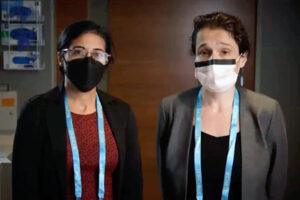
Point-of-care ultrasound (POCUS) has become an increasingly common and useful tool with important applications in pulmonary medicine, both inside and outside of the ICU. The session Thoracic Ultrasonography for the Pulmonary Consultant featured a panel of experienced sonographers who, through real-life case examples and video demonstrations, shared some important tips to consider and some potential pitfalls to avoid when using this imaging modality.
Lewis Satterwhite, MD, FCCP, Associate Professor in the Division of Pulmonary, Critical Care, and Sleep Medicine at the University of Kansas Medical Center, began the session with an overview of the basics of thoracic ultrasound and its utility in pulmonary medicine.
“It is a really powerful tool that is now readily available in a multitude of settings and, put simply, many of our other tools are inadequate,” Dr. Satterwhite said. “While CT scan of the chest is wonderfully accurate for identifying all kinds of abnormalities, the other tools that we use—including history, physical exam, and chest x-rays—ultimately do not provide the diagnostic accuracy that we need to provide adequate and excellent care for our patients.”
He cited recent studies showing that the diagnostic accuracy of ultrasound equals, and in many circumstances surpasses, that of chest x-rays.

“Data over a number of years has associated thoracic ultrasound with improving procedural safety, aiding in choosing the right procedure at the right time, and decreasing complications,” Dr. Satterwhite said. “Ultrasound is fast, effective, reliable, and has been demonstrated to provide clarity in otherwise unclear situations. If you use it as part of a comprehensive evaluation, it can improve your diagnostic accuracy of patients presenting with unclear pathologies.”
In a joint presentation, Gisela Banauch, MD, MS, FCCP, Associate Professor at the University of Massachusetts Medical School and Director of the Point of Care Medical Critical Care Ultrasound Program at UMass Memorial Medical Center, and Amik Sodhi, MD, FCCP, Medical Director of Critical Care Services at the University of Wisconsin, described the basic steps in preparing for a full lung ultrasound exam.
Using the right transducer and applying the right settings, they said, are keys to obtaining the most useful images.
“For the lung ultrasound exam, the phased-array transducer is the transducer that we use most often, but if you want to focus on the pleural line, you can also use the high-frequency linear transducer,” Dr. Banauch said. “Your transducer may have a cardiac preset as well as a number of other presets, but CHEST recommends changing to an abdominal preset.”
Once the area to image is defined, Dr. Sodhi said the gain and the depth of the scan must be appropriately set.

“Adequate gain is going to depend on what you’re trying to image—if you’re trying to focus on the pleura, you’re going to down-gain, but if you’re more focused on the parenchyma, then you’re potentially going to need more gain and possibly more depth as well,” Dr. Sodhi said.
Ariel Shiloh, MD, FCCP, Director of the Critical Care Medicine Consult Service and Associate Professor of Medicine at Montefiore Medical Center/Albert Einstein College of Medicine, followed with a discussion of A-line and B-line artifacts that can be seen when performing lung ultrasound and how the evaluation of these artifacts can be useful in determining the presence or absence of sliding lung.
“With sliding lung, you’ll see a subtle shimmering of the pleural line, representing the visceral and parietal pleura sliding against each other with respiration,” Dr. Shiloh said. “Importantly, if you’re doing this and you see this pattern, you are ruling out a pneumothorax at the site of the probe and nowhere else, only at the site of the probe.”
When signs of sliding are absent, he said that can be suggestive of pneumothorax.

“But it may also be due to a lack of ventilation or apnea, so if you right mainstem intubate somebody or if the patient is not being bagged or ventilated, you will also have absent lung sliding,” Dr. Shiloh said. “Additionally, absent lung sliding may occur in advanced inflammatory diseases or if the patient has previously undergone pleurodesis.”
Next, Kenneth Lyn-Kew, MD, Associate Professor of Medicine, Division of Pulmonary, Critical Care and Sleep Medicine, National Jewish Health in Denver, reviewed the use of ultrasound in recognizing alveolar consolidation.
“First of all, alveolar consolidation is a descriptive term not a diagnostic term, so whenever you see this, there’s a differential that goes with it,” Dr. Lyn-Kew said. “It can be caused by a multitude of processes, most notably pneumonia and atelectasis; however, other things can mimic this pattern as well, such as large adherent clots to the diaphragm. I’ve also seen lung cancers that are space-occupying mimic this pattern as well.”

Paru Patrawalla, MD, FCCP, Associate Professor of Medicine, Division of Pulmonary, Critical Care and Sleep Medicine, concluded the session with a discussion of the use of ultrasound in identifying pleural-based masses and effusions.
Confidently identifying a pleural effusion with ultrasound, she said, begins with identifying anatomic borders—chest wall, diaphragm, and lung—and recognizing dynamic changes in the area being imaged.
“It’s really important to not just identify your three borders and the anechoic space in the middle, but you also want to prove that anechoic space you’re seeing is actually fluid,” Dr. Patrawalla said. “And you do that by seeing something dynamic—it might be the lung moving and flapping around or it might be a plankton sign where you see little echogenic debris floating around in the fluid—that really proves to you that the space you’re seeing is actually fluid.”
ACCESS SESSIONS ON DEMAND
Registered CHEST 2021 attendees have continued access to 200+ educational sessions until October 1, 2022. Watch sessions on your own schedule and earn up to 50 CME credits/MOC points.
Don’t forget to claim your credit! The deadline is December 15, 2022, at 11:59 pm CT.





